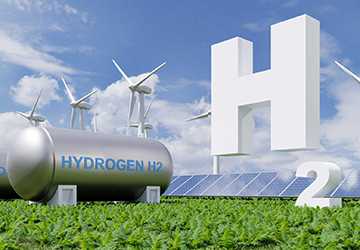The Path Ahead for Renewable Energy Technology
Renewable energy technologies are at a critical moment in history. Given the dual challenges of climate change and finite fossil fuel resources, the need for sustainable, clean energy solutions has never been more urgent. Renewable energy technologies promise breakthrough innovations that redefine how we power the world. Let's look at the fundamental advances that will shape the future of renewable energy.

Solar Energy: More Than Just Solar Panels
Solar energy has made significant progress, but the future looks even brighter. The efficiency of photovoltaic (PV) cells is improving at an astonishing rate, driven by material innovations such as perovskite solar cells. These cells promise to achieve higher efficiencies at lower costs, making solar energy more accessible and practical for widespread use.
In addition, the development of solar skins and transparent solar panels means that almost any surface can be turned into an energy generator. Imagine windows, building facades, and even cars harnessing the sun's energy. This integration would reduce our reliance on the traditional grid and create energy-autonomous buildings and vehicles, an essential step toward the clean energy technologies of the future.
Key Innovations in Solar Energy
● Perovskite Solar Cells: Higher Efficiency, Lower Cost.
● Solar Skins and Transparent Panels: Turn Any Surface into an Energy Generator
● Energy autonomous structures: Buildings and vehicles are powered independently.
Wind energy: Harnessing the air
Wind energy is another cornerstone of renewable energy technology. Offshore wind farms and airborne wind turbines are the future of wind energy. Offshore wind farms can capture stronger, more stable winds at sea, significantly increasing energy production.
Airborne wind turbines, such as those developed by companies such as Makani, use kites or drones to harness wind energy at higher altitudes, where winds are more stable and robust. Regarding future clean energy technology, these turbines can produce twice the power of traditional wind turbines using less material and land area.
Future directions for wind energy
● Offshore wind farms: Stronger and more stable winds at sea.
● Airborne wind turbines: Harnessing high-altitude winds to improve efficiency.
● Material and space efficiency: Less material and land are required for turbines.
Energy storage: The tipping point
One of the biggest challenges facing future clean energy technology is storage. Because solar and wind energy are intermittent, sufficient storage is necessary for reliable power. Technological developments in batteries, particularly solid-state batteries, have the potential to revolutionize energy storage. These batteries offer higher energy density, longer lifespan, and improved safety than lithium-ion batteries.
Another positive trend is the application of large-scale energy storage technologies such as pumped hydro and molten salt. By storing energy during periods of high demand and releasing it during periods of low demand, these systems have the potential to provide a stable energy supply.
Advances in energy storage
● Solid-state batteries: higher energy density, longer lifespan, and better safety.
● Pumped hydro: large-scale energy storage during production peaks.
● Liquid salt storage: efficient storage and release of energy.
Smart grid: the backbone of future energy systems
As renewable energy becomes more widespread, traditional power grids must change to support the promise of renewable energy technologies. Integrating renewable energy into our current infrastructure requires intelligent grids that use digital technology to monitor and control energy flows. These networks can achieve real-time balancing of supply and demand, reduce energy waste, and improve the reliability of power systems.
Benefits of smart grids
● Real-time energy management: efficient balancing of supply and demand.
● Reduced energy waste: improved overall energy efficiency.
● Decentralized energy generation: enabling local generation, storage, and energy sharing.
Hydrogen: A Clean Fuel
Many have hailed hydrogen as the fuel of the future. Hydrogen is an entirely pure energy source because it produces only water as a byproduct in fuel cells. For hydrogen to be widely used, efficient and cost-effective manufacturing, storage, and transportation processes must be developed.

Electrolysis is increasingly economical and efficient for splitting water into hydrogen and oxygen. The method uses renewable energy as fuel and can produce green hydrogen, providing a sustainable alternative to fossil fuels in the transportation and industrial sectors. This is an essential step in the prospects of renewable energy technologies.
Advances in Hydrogen
● Fuel cells: A clean energy source with water as the only byproduct.
● Efficient electrolysis: Improved methods for producing green hydrogen.
● Storage and transportation: Innovations for efficient use of hydrogen.
The role of artificial intelligence
Artificial intelligence (AI) will play an essential role in the future of renewable energy. AI can optimize energy production, storage, and consumption by analyzing large amounts of data and making real-time adjustments. For example, AI can predict energy demand patterns, optimize the operation of wind turbines and solar panels, and improve the efficiency of energy storage systems.
In addition, AI-driven predictive maintenance can reduce downtime, extend the life and prospects of renewable energy technologies, and improve their reliability and cost-effectiveness.
AI in Renewable Energy
● Optimization: Improve production, storage, and consumption.
● Predictive maintenance: Reduce downtime and extend the life of infrastructure.
● Data analytics: Adjust in real time to improve efficiency.
The way forward
The transition to renewable energy comes with challenges. It requires significant investment, supportive policies, and global cooperation. However, the potential benefits are enormous. Renewable energy can reduce greenhouse gas emissions, create jobs, and improve energy security.
To accelerate this transition, governments and businesses must invest in research and development, support new technologies, and create regulatory frameworks that foster innovation and adoption. Public awareness and acceptance are also critical. Educating people about the benefits of renewable energy and dispelling myths and misconceptions can drive demand and support for these technologies.
Steps to accelerate the transition
● Invest in research and development: Fund new technologies.
● Support policies: Regulatory frameworks that foster innovation.
● Public awareness: Educate and support renewable energy.
Conclusion
The future of clean energy is bright. Innovations in solar and wind power, energy storage, smart grids, hydrogen fuels, and artificial intelligence will transform our energy system. By embracing these advances, we can build a sustainable, clean energy future that benefits the planet and its inhabitants. The road ahead is challenging, but with determination and innovation, we can achieve a world powered by renewable energy.
Related Posts
- 4 Cybersecurity Measures to Protect Your Online Identity
- 10 interesting facts about cells: The building blocks of life
- How to choose the exemplary cloud storage service
- Recent Advances and Applications of Artificial Intelligence
- The Transformative Impact of Wearable Technology on Health Monitoring
- 10 Popular 5G Applications Revolutionizing Communication